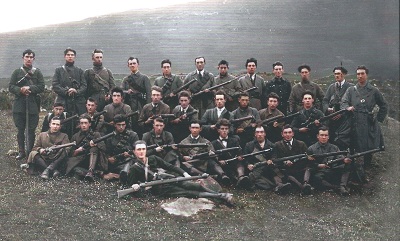 Seán Cadden, Harry Hughes, Vincent Keane, James Kelly (eds.), The Men of the West- West Mayo Brigade War of Independence 1919-1921, Westport Historical Society, (2021), ISBN:9780953608683, hardback, pp.272, €25. The contributors and editors of this fine book are to be complimented for researching and recording for us and for posterity the lives and times of members of the West Mayo Brigade of the Irish Republican Army (IRA) during the War of Independence. These volunteers decided that they could not stand by and condone a war of terror by the ‘Black and Tans’ and Auxiliaries to suppress the will of the people democratically expressed in the 1918 general election for an independent Ireland. These young, idealistic, and courageous volunteers engaged in dangerous activities and had ‘to go on the run’, often cold and hungry, and always in fear for their lives. They and their families made huge sacrifices for the cause in which they believed, and it is most appropriate that they are remembered. The West Mayo Brigade of the IRA was established late in the War of Independence in September 1920, with four brigades, the Ist Castlebar, 2nd Newport, 3rd Westport, and 4th Louisburgh, each with its own active service unit. These service units were amalgamated early in 1921, and they participated in several raids and ambushes against Crown forces, culminating in the Carrowkennedy ambush on 2 June 1921, just over a month before the Truce in the war came into effect on July 11. The book has a foreword by Vice-Admiral Mark Mellett and a preface by Harry Hughes, chairperson of the West Mayo Brigade Centenary Committee. These are followed by a Timeline of Events and original articles by Vincent Keane, Seán Cadden, Dr. Myles MacEvilly and James Kelly, with a collection of previously published studies. Pride of place is given to the iconic photograph of members of the West Mayo Brigade, known as The Men of the West, taken by Jack Leonard at Derrymartin on the slope of Nephin, late on June 21, 1921. James Kelly provides fascinating brief profiles of the 31 men in the photograph. Seán Cadden provides profiles for ‘Active Service Unit Members missing from the Leonard Photograph’, and of ‘Other Active Volunteers’, as well as a list of those interned as at July 11, 1921. It is most interesting to read how their lives developed and where they ended up. We are told that the average age of the men in the photograph was 22, many of them teenagers, with the oldest Michael Kilroy O/C only 36 and the youngest Tommie Heavey just sixteen summers. At a commemoration for one active service unit in 1933, it was recalled that of the 46 original members, eleven were killed in action, 12 emigrated, and of the 23 who stayed at home 12 were unemployed (p.106). After the Carrowkennedy ambush, the homes of Michael Kilroy and Joe Ring were burned to the ground. All this shows the sacrifices and deprivations suffered by these young men. There are more comprehensive profiles of Thomas Derrig (the first Officer Commanding(O/C), and later Minister for Education 1932-39 and 1940-48), Michael Kilroy (who became O/C in January 1921 following the arrest of Thomas Derrig), Dr. John A Madden, Joe Ring(who was killed in the Ox mountains on September 14, 1922 during the Civil War), Jack Connolly, John P McCormack, Joseph McBride, William (Rick) Joyce, Patrick J. Kelly, Peter (Brod ) McLoughin, Jack Leonard, Jack Keane, Jim Moran, Charles Hughes and Michael Moran. Vincent Keane in his essay entitled ‘The Irish Volunteers in Westport 1914-21’ places the West Mayo Brigade in its local historical context. He also has articles about ‘Westport ‘A’ Company 3rd Battalion, Brockagh ‘B’ Company, 2nd Battalion’, ‘Financing the Activities of the West Mayo Brigade’, ‘Cumann na mBan in Westport 1915-1923’, and ‘Westport Sluagh Fianna Éireann’. There are accounts of the various ambushes, with several personal and family memoirs. There are lists of Republican and RIC casualties 1919-23, the Mayo connection, and Casualties –West Mayo Brigade area during the War of Independence and Civil War 1919-1923, together with numerous photographs, especially various commemorations and reunions, as well as poems, songs, and references for each chapter. My only reservation is that women do not receive their due recognition, only one chapter. Women had major roles in Mayo and around the country. In addition to the contributors and editors, this book is a credit to the designers, Darragh Joyce and Ronan Hughes at Portwest Graphics Department (who also created a website in conjunction with the book westmayo.ie), and to Westport Historical Society, the publisher. They all, including the people listed in the acknowledgements, have produced a special book of enduring value to remember The Men of the West. Exploring Mayo by Bernard O’Hara is now available Worldwide as an eBook for the amazon Kindle application. The print version of Bernard O’Hara’s book Exploring Mayo can be obtained by contacting www.mayobooks.ie. www.mayobooks.ie also sell the print versions of Killasser - Heritage of a Mayo Parish , Anseo and Davitt. Bernard O'Hara's book entitled Killasser: Heritage of a Mayo Parish is now on sale in the USA and UK as a paperback book at amazon.com, amazon.co.uk or Barnes and Noble It is also available as an eBook from the Apple iBookstore (for reading on iPad and iPhone), from Amazon.com and Amazon.co.uk (Kindle & Kindle Fire) and from Barnesandnoble.com (Nook tablet and eReader). An earlier publication, a concise biography of Michael Davitt, entitled Davitt by Bernard O’Hara published in 2006 by Mayo County Council , is now available as Davitt: Irish Patriot and Father of the Land League by Bernard O’Hara, which was published in the USA by Tudor Gate Press (www.tudorgatepress.com) and is available from amazon.com and amazon.co.uk. It can be obtained as an eBook from the Apple iBookstore (for reading on iPad and iPhone), from Amazon.com and Amazon.co.uk (Kindle & Kindle Fire) and from Barnesandnoble.com (Nook tablet and eReader). |